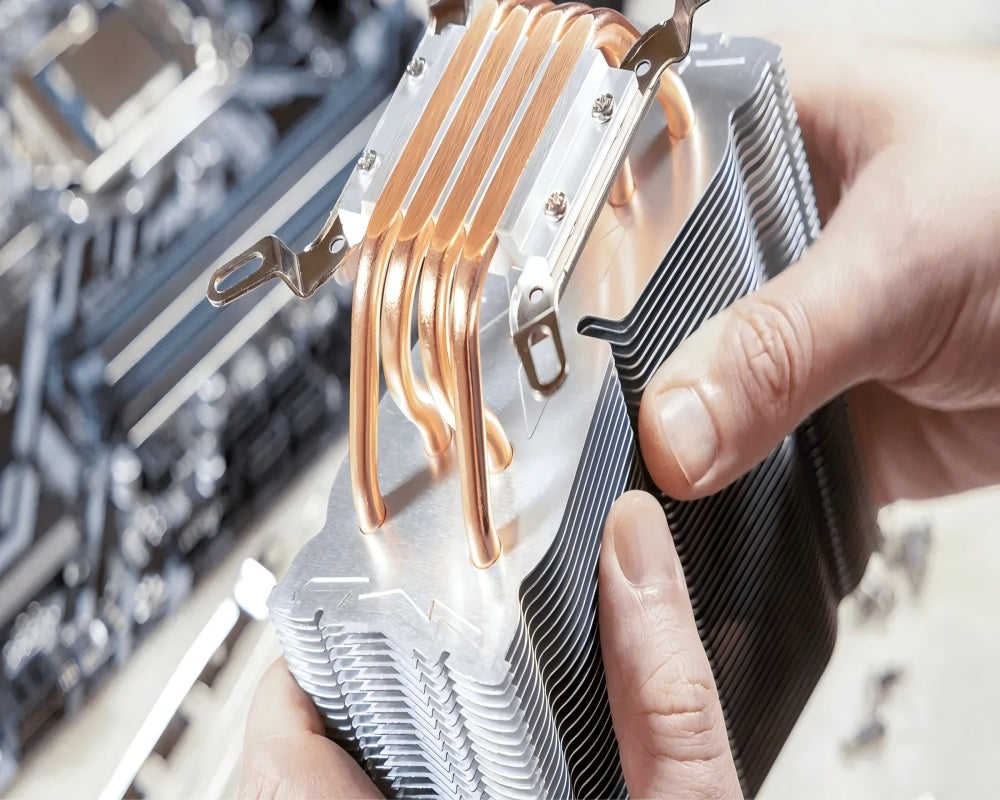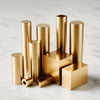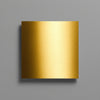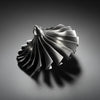Choosing the Right Manufacturing Solution for Aluminum Heat Sinks

Heat sinks may be small in size, but they play a critical role in thermal management for high-heat electronic components. For instance, computers generate prolonged heat during operation, and CPU heat sinks effectively dissipate this heat, significantly extending the device’s lifespan.
Heat Sink Material Options

The working principle of heat sinks is fundamentally simple: maximize surface area to enhance heat dissipation. An effective heat sink must:
-
Absorb heat rapidly from the source (high thermal conductivity)
-
Release heat efficiently to the environment (optimized airflow design)
-
Maintain thermal equilibrium with minimal thermal resistance
Common Manufacturing Solutions
1.Aluminum Extrusion
Limitations of Extruded Fins
-
Fin Aspect Ratio (Pin-Fin Ratio):
-
Defined as fin height (H) ÷ fin thickness (T)
-
Typical extrusion limit: H:T ≤ 15:1
-
Higher ratios increase effective cooling area but reduce structural integrity
-
-
Thermal Performance Constraints:
-
Limited fin density due to die strength
-
Lower surface-area-to-volume ratio vs. bonded/skived fins
-
Primary Applications:
-
Straight/Louvered Fins: For natural convection
-
Cylindrical Pin-Fins: For low-turbulence forced airflow
2.CNC Machining

CNC machining of aluminum encompasses multiple operations:
✅ Primary Processes:
-
Turning (for cylindrical features)
-
Drilling (hole tolerance: ±0.05mm)
-
Milling (3D contours, Ra 0.8–3.2μm)
-
Grinding (precision surfaces ≤0.4μm)
✅ Typical Applications:
-
Plate forming (flatness ≤0.1mm/m)
-
Heat sink fin profiling (fin thickness ≥0.8mm)
-
Base surface finishing (parallelism ≤0.03mm)
⚠️ Key Limitation:
-
Rapid Tool Wear:
-
Carbide tools: 60–120 mins life (6061-T6 @ 300m/min)
-
Requires frequent:
-
Tool changes (avg. 8–12/day)
-
Operator oversight (labor cost: $15–25/hr)
-
-
3.Die Casting

Manufacturing Principle:
Die-casting mimics injection molding but for metals:
-
Melting: Aluminum alloy (e.g., ADC12) heated to 680–720°C
-
Injection: Molten metal forced into steel mold at 500–1,500 bar
-
Solidification: Rapid cooling under 50–100 tons clamping force
-
Post-Processing: Trimming, deburring, surface finishing
Advantages:
-
Complex Geometries: Integrates thin fins (≥0.6mm), dense arrays (8–12 fins/cm)
-
High Volume: Cycle time as fast as 30–60 seconds per unit
-
Net-Shape Production: Minimal secondary machining required
Disadvantages:
⚠️ Thermal-Performance Trade-offs:
| Property | Die-Cast | Wrought Aluminum |
|---|---|---|
| Thermal Conductivity | 80–120 W/m·K | 160–220 W/m·K |
| Tensile Strength | 240–290 MPa | 310–350 MPa |
| Caused by: |
-
Porosity (2–5% void volume)
-
Non-uniform grain structure
What Common Surface Treatment Options are Available?
Sandblasting
Sandblasting applies strong pressure to the workpiece surface and effectively removes dirt or tool marks from the machined aluminum surface. It also creates a more uniform and shiny appearance and improves the mechanical properties and fatigue resistance of the aluminum heat sink surface.
Wirebrushing
Wirebrushing can give parts a more metallic feel and a more stylish appearance. In addition to its decorative properties, it also increases the part's heating surface area, improving the efficiency of the aluminum heat sink.
Anodizing
Anodizing is one of the most widely used surface treatments for aluminum heat sinks today. Anodizing creates a protective film on the surface of the part, which not only protects the part from scratches, wear, and damage, but also overcomes the surface hardness limitations of aluminum alloys.
Electroplating
Electroplating can effectively protect and decorate aluminum heat sinks. The principle is similar to that of anodizing. It forms a protective film on the surface of the part, preventing oxidation. It also improves the part's wear resistance, reflectivity, conductivity, and corrosion resistance.
Contact Us
XTJ has extensive experience in aluminum heat sink processing. If you have any new project requirements, please send us your data for a quote.
-
Posted in
cnc machining, Heat Sink, Prototyping





